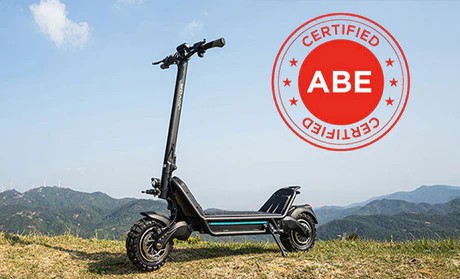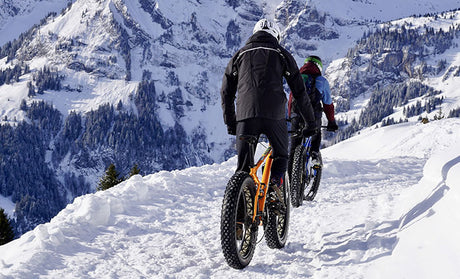Regarding Electric Scooters, tire size is critical to performance, ride comfort, and overall usability. Whether you're a commuter, casual rider, or adventure enthusiast, understanding the differences between various tire sizes and considering your daily usage environment can help you make the most informed choice and decision.
This article comprehensively compares different tire sizes for electric scooters, highlighting their advantages, disadvantages, and best use cases.

Contents
- Common Tire Sizes for Electric Scooters
-
Small Tire (8-10 inches) Electric Scooters
1. Pros of Small Tires
2. Cons of Small Tires
3. Best Use Cases for Small Tires -
Medium Tires (10-14 inches) Electric Scooters
1. Pros of Medium Tires
2. Cons of Medium Tires
3. Best Use Cases for Medium Tires -
Large Tires (14 inches) Electric Scooters
1. Pros of Large Tires
2. Cons of Large Tires
3. Best Use Cases for Large Tires -
Tire Types and Their Impact
1. Pneumatic Tires
2. Solid Tires
3. Tubeless Tires -
Performance Comparison
1. Speed and Acceleration
2. Stability and Control
3. Ride Comfort and Shock Absorption -
Durability and Maintenance
1. Wear and Tear
2. Maintenance Needs
3. Repair and Replacement Considerations -
Terrain Compatibility
1. Urban and Paved Roads
2. Off-Road and Rough Terrains
3. Mixed Terrain Use -
Safety Considerations
1. Traction and Grip
2. Handling in Different Weather Conditions
3. Braking Performance -
Cost Implications
1. Initial Cost of Tires
2. Long-Term Cost (Maintenance, Replacement) -
Environmental Impact
1. Material and Production Considerations
2. Disposal and Recycling - User Preferences and Recommendations
- End
Common Tire Sizes for Electric Scooters
Electric scooters typically come with tires in three main size categories: small (8-10 inches), medium (10-14 inches), and large (14 inches). Each size offers distinct advantages and disadvantages, making them suitable for different riding styles and environments.
| Tire Size (inches) | Advantages | Disadvantages | Suitable Terrain |
|---|---|---|---|
| 8-10 inch E-scooters |
|
|
|
| 10-14 inch E-scooters |
|
|
|
| 14 Inch E-scooters |
|
|
|
Small Tire (8-10 inches) Electric Scooters
1. Pros of Small Tires
- Lightweight: Smaller tires electric scooters reduce the overall weight of the scooter, making it easier to carry and maneuver.
- Compact Design: Ideal for compact and foldable scooter models, perfect for urban commuting and storage in tight spaces.
- Faster Acceleration: Smaller tires can provide faster acceleration due to reduced rolling resistance.
2. Cons of Small Tires
- Less Stability: Smaller contact patch with the ground leads to less stability, especially at higher speeds.
- Limited Shock Absorption: Less ability to absorb shock and vibration from rough surfaces, resulting in a bumpier ride.
- Lower Traction: Reduced grip on wet or uneven roads can affect safety.
3. Best Use Cases for Small Tires
Ideal for short urban commutes on flat, paved roads.
For riders looking for a lightweight, portable scooter.

Medium Tires (10-14 inches) Electric Scooters
1. Pros of Medium Tires
- Balanced performance: A good balance between stability and maneuverability.
- Improved comfort: Better shock absorption and a smoother ride than small tires.
- Good traction: Enhanced grip on a variety of surfaces for increased safety and control.
2. Cons of Medium Tires
- Moderate weight: Heavier than small tires, which affects portability.
- Higher cost: Typically more expensive than small tires, both in terms of initial cost and maintenance costs.
3. Best Use Cases for Medium Tires
For long commutes and mixed terrain, including light off-road conditions.
Great for riders looking for a balance between comfort and performance.

Large Tires (14 inches) Electric Scooters
1. Pros of Large Tires
- Superior stability: A larger contact area with the ground enhances stability, especially at higher speeds.
- Excellent shock absorption: Better absorption of shocks and vibrations, providing a comfortable ride on rough terrain.
- Enhanced traction: Better grip on a variety of surfaces, including slippery and uneven roads.
2. Cons of Large Tires
- Increased weight: Heavier tires increase the overall weight of the scooter, making it less portable.
- Bulkier design: May affect the compactness and foldability of the scooter.
- Higher cost: Higher initial purchase and maintenance costs.
3. Best Use Cases for Large Tires
Great for off-road adventures and long commutes.
For riders who prioritize comfort and stability over portability.
Tire Types and Their Impact
1. Pneumatic Tires
- Advantages: Better shock absorption, superior traction, and a smoother ride.
- Disadvantages: Prone to punctures, requiring regular maintenance and repairs.
2. Solid Tires
- Advantages: Puncture-proof and low maintenance.
- Disadvantages: Less comfortable due to reduced shock absorption, and can be heavier.
3. Tubeless Tires
- Advantages: Combines the benefits of pneumatic tires with reduced risk of punctures.
- Disadvantages: More expensive and complex to install and maintain.

Performance Comparison

1. Speed and Acceleration
Small tires(8-10 inch) offer quicker acceleration, while medium tires(10-14 inch) and larger tires(14 inch) provide better stability at higher speeds.
2. Stability and Control
Larger tires enhance stability and control, especially on uneven surfaces.
3. Ride Comfort and Shock Absorption
Medium tires(10-14 inch) and larger tires(14 inch) and pneumatic options offer superior comfort and shock absorption, making them ideal for longer rides and rough terrains.
Durability and Maintenance
1. Wear and Tear
Smaller tires(8-10 inch) tend to wear out faster due to higher rolling resistance.
Medium tires(10-14 inch) and larger tires(14 inch) generally have a longer lifespan but may require more maintenance.
2. Maintenance Needs
Pneumatic tires require regular checks for pressure and potential punctures.
Solid tires are low maintenance but may need replacement sooner due to wear.
3. Repair and Replacement Considerations
Smaller tires are easier and cheaper to replace.
Medium tires(10-14 inch) and larger tires(14 inch) , while more durable, can be costlier and more complex to repair or replace.
Terrain Compatibility
1. Urban and Paved Roads
Small to medium tires are well-suited for smooth, paved surfaces.
Medium tires offer a good balance for mixed urban environments.
2. Off-Road and Rough Terrains
Medium tires(10-14 inch) and large tires(14 inch) excel on rough terrains and off-road conditions, providing stability and comfort.
3. Mixed Terrain Use
Medium to large tires are versatile for mixed terrain, offering a blend of stability, comfort, and performance.
Safety Considerations
1. Traction and Grip
Larger tires provide better traction and grip, enhancing safety on various surfaces.
2. Handling in Different Weather Conditions
Pneumatic and large tires perform better in wet conditions due to improved grip.
Solid tires can be less effective in slippery environments.
3. Braking Performance
Medium and larger tires generally offer better braking performance due to increased contact with the ground.
Cost Implications
1. Initial Cost of Tires
Small tires are cheaper initially, while larger and pneumatic tires cost more.
2. Long-Term Cost (Maintenance, Replacement)
Solid tires are cost-effective in the long run due to low maintenance.
Pneumatic tires, while comfortable, incur higher maintenance and replacement costs.
Environmental Impact
1. Material and Production Considerations
Solid tires may have a higher environmental impact due to synthetic materials.
Pneumatic tires, while offering better performance, require more resources to produce and maintain.
2. Disposal and Recycling
Proper disposal and recycling of old tires are crucial for minimizing environmental impact
User Preferences and Recommendations
A survey of user preferences shows that urban commuters tend to prefer small and medium tire sizes for their combination of comfort and performance. Adventure enthusiasts and long-distance riders tend to prefer medium and large tire sizes for their stability and shock absorption. Experts recommend considering your typical riding environment and personal preferences when choosing a tire size.
End
Choosing the right tire size for your electric scooter depends on various factors, including your riding style, typical terrain, and personal preferences. Small tires are great for portability and quick acceleration, medium tires offer a balanced performance, and large tires excel in comfort and stability. By understanding the pros and cons of each tire size, you can make an informed decision that enhances your riding experience.















